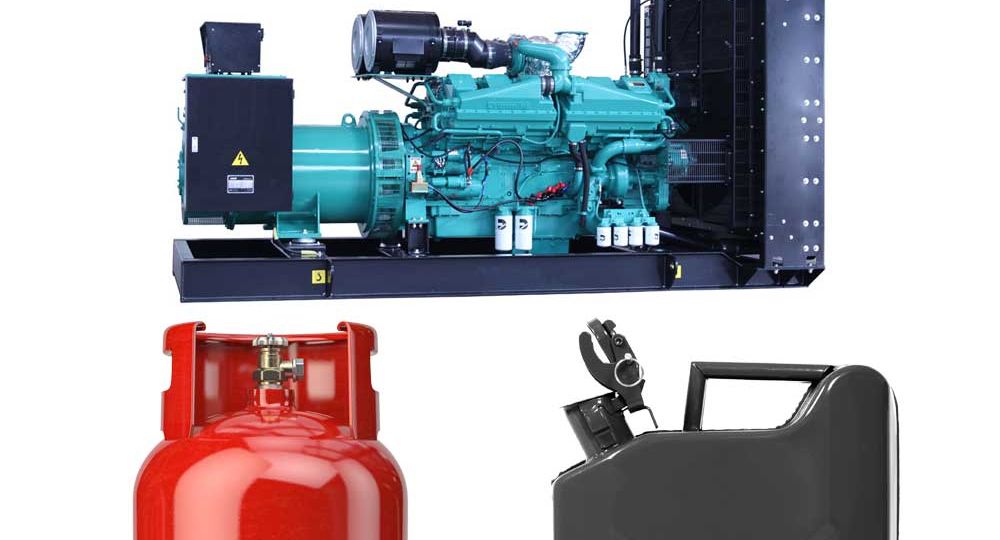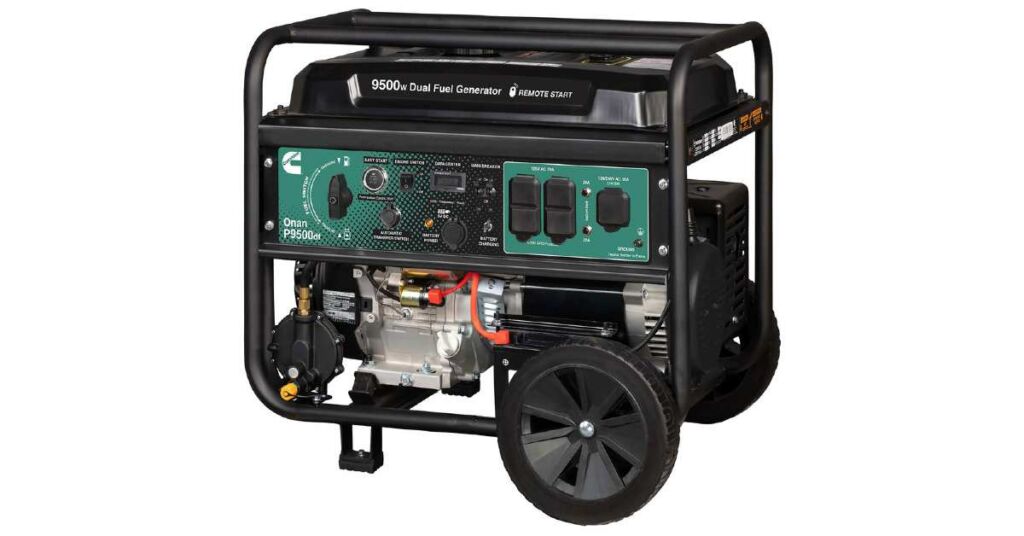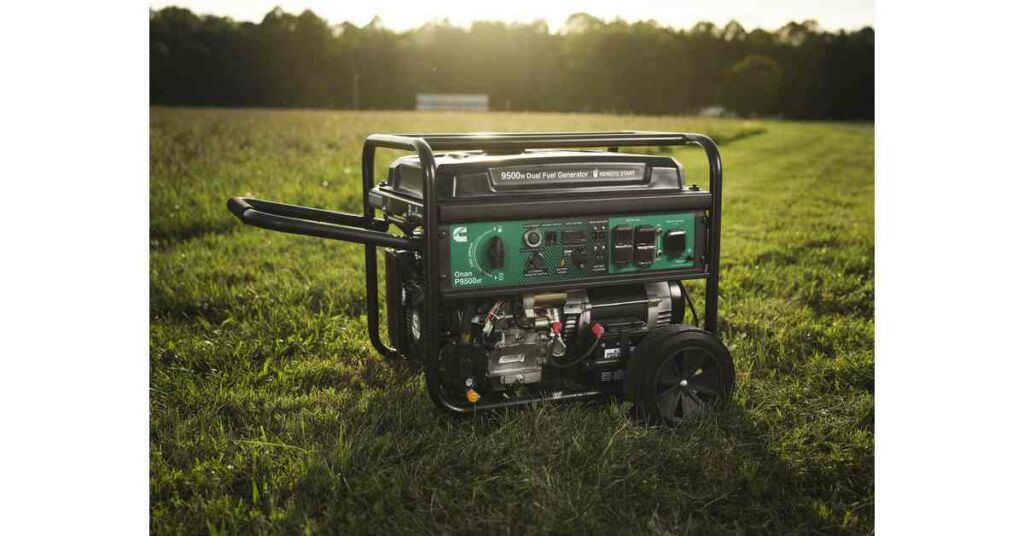Dual fuel generators are a compelling solution for individuals and businesses seeking reliable power sources. In this article, we delve into the mechanics of dual fuel generators, their advantages, drawbacks, and their various applications.
Dual Fuel Generator: A dual fuel generator is a highly versatile power generation system that operates on two distinct fuel sources, typically gasoline and propane, enhancing its adaptability and reliability in various situations. This innovative power solution is designed to seamlessly switch between these fuels, optimizing efficiency, continuous use autonomy time and offering users a robust source of electricity.
Importance of Dual Fuel Generators
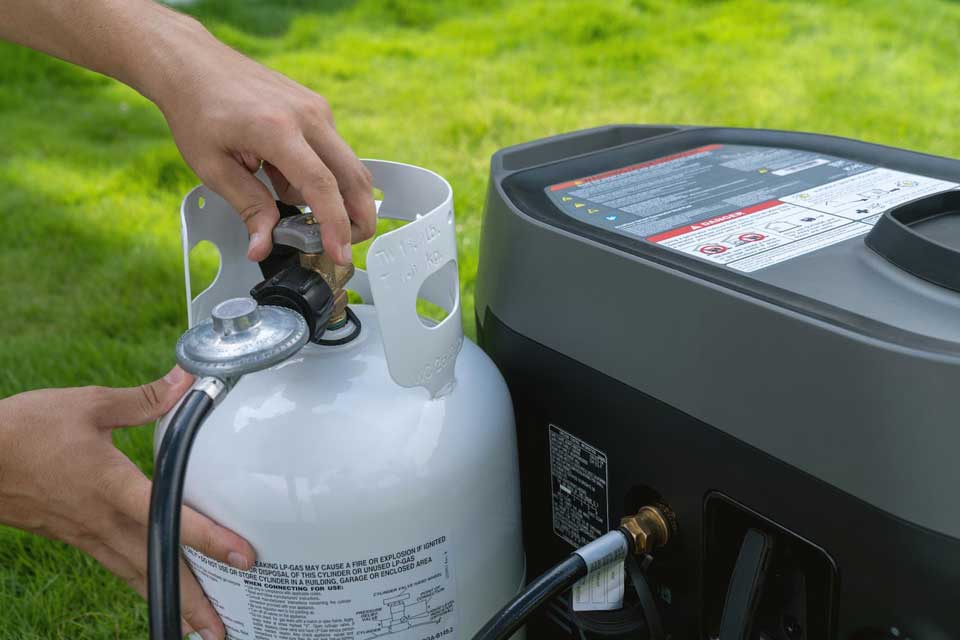
Traditional power generators depend on only one type of fuel. Sadly, they have a tendency to lose power when emergencies stretch for a prolonged period. Depending solely on a particular energy source, be it solar, diesel, or gasoline, limits your ability to maintain electricity in your home during an extended blackout.
Dual-fuel generators employ a combination of propane, natural gas, diesel, or gasoline as their fuel sources. These generators are designed to seamlessly switch between fuels, either through manual intervention or automatic mechanisms, depending on the power needs or fuel availability.
The versatility of a dual fuel generator, which can utilize multiple fuel sources, significantly extends its operational duration and broadens its scope of application. Whether you need it for your home, business, or any industrial setting, this generator’s ability to adapt to different fuels ensures a longer period of uninterrupted power supply.
In residential use, these generators serve as a dependable backup power source during unexpected outages, ensuring essential appliances and systems continue to function seamlessly.
In commercial settings, businesses often employ dual fuel generators to maintain operations during power interruptions, safeguarding against potential revenue losses and productivity disruptions. Their ability to switch between fuels allows companies to rely on the most readily available and cost-effective option at any given time.
Moreover, in industrial scenarios, where power demands can be substantial, these generators play a vital role in supplying the necessary energy for heavy machinery and critical processes. Their robust construction and ability to operate continuously make them an indispensable asset in manufacturing.
In remote construction sites, where grid power is often unavailable, dual fuel generators provide a consistent and dependable source of electricity. They power heavy machinery, tools, and lighting systems, allowing construction projects to progress without interruption.
In the realm of recreational activities, such as camping and RV trips, dual fuel generators enhance the outdoor experience. They offer a convenient way to charge devices, run appliances, and provide essential comforts while off the grid.
It’s worth noting that the dual fuel generator is an environmentally conscious choice, as propane is a cleaner-burning fuel than gasoline, resulting in reduced emissions and a smaller carbon footprint. This eco-friendly feature makes it an appealing choice for those looking to minimize their impact on the environment.
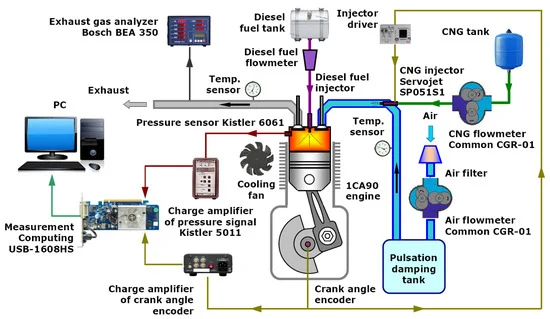
How Dual Fuel Generators Work?
Dual fuel generators operate through a sophisticated combustion process, enabling the generator to accept two types of fuel – typically gasoline and propane. The generator uses a switching mechanism to transition between these fuels, allowing for uninterrupted power supply during outages.
The automatic fuel switching mechanism in a dual fuel generator operates seamlessly, ensuring uninterrupted power during fuel transitions. This technological advancement enables the generator to adapt to changing conditions, whether you’re camping in the wilderness, working at a remote job site, or experiencing power outages at home.
Furthermore, many dual fuel generators come equipped with advanced safety features like low-oil shutoff and overload protection. These mechanisms safeguard the generator’s engine and electrical components from damage, ensuring extended durability and dependable performance.
The Switching Mechanism. How does it work?
The switching mechanism of a dual power generator is designed to seamlessly transition between different fuel sources based on certain conditions or user preferences. Here is a technical and detailed explanation of how this mechanism operates:
1. Fuel Detection: The generator is equipped with sensors or fuel detection systems that monitor the availability and levels of each fuel source. These sensors ensure accurate fuel detection and management.
2. Control Panel: The generator’s control panel is the central hub where the switching mechanism is controlled. It allows users to manually select the desired fuel source or enables automatic switching based on preconfigured settings.
3. Fuel Selection: When the generator is set to automatic mode, the switching mechanism evaluates the fuel availability and quality. If one fuel source is running low or becomes unavailable, the mechanism initiates a transition to the alternate fuel source.
4. Valve Control: The switching mechanism activates valves that regulate the flow of fuel from the selected source to the generator’s engine. This ensures a smooth transition while maintaining a consistent power output.
5. Carburetor or Fuel Injectors: Depending on the generator’s design, the switching mechanism adjusts the fuel intake system to adapt to the characteristics of the selected fuel source. This may involve modifying the carburetor settings or adjusting the fuel injectors’ parameters.
6. Engine Adjustment: The generator’s engine management system is synchronized with the switching mechanism. It monitors and adjusts various engine parameters, such as fuel-air mixture ratios, ignition timing, and other factors, to optimize performance based on the chosen fuel source.
7. System Synchronization: The switching mechanism ensures synchronization between the fuel valve control, carburetor/fuel injectors adjustment, and engine management system. This coordination enables a seamless and efficient transition between fuel sources without interruptions or fluctuations in power output.
8. Safety Measures: Dual power generators often incorporate safety features to prevent any issues during fuel switching. For example, there may be safeguards in place to prevent simultaneous operation of both fuel sources, which could lead to engine damage or unsafe conditions.
9. User Control: In addition to automatic mode, the switching mechanism allows manual control of fuel selection. Users can manually switch between fuel sources using the control panel, providing flexibility and customization options to suit specific requirements or preferences.
It’s important to note that the specifics of the switching mechanism can vary between different dual power generator models. Advanced models may incorporate advanced electronic controls, sophisticated fuel management systems, and enhanced safety measures to ensure reliable and efficient fuel switching.
Pros of Using a Dual Fuel Generator
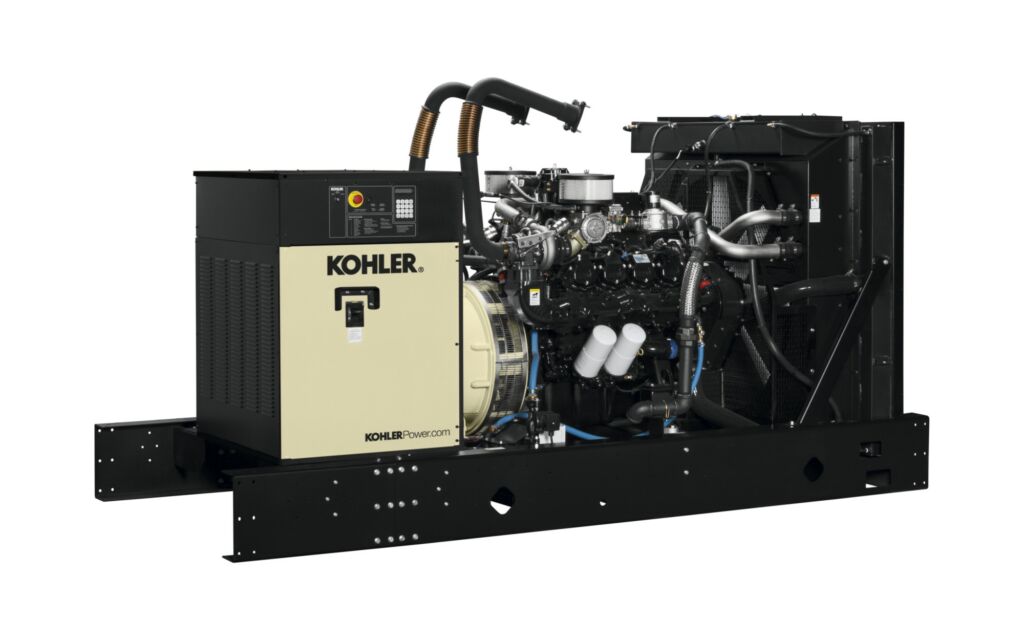
The primary advantage of investing in dual generators is the ability to tap into various fuel options. Certain fuels perform better depending on the circumstances.
For example, gasoline, a readily available fuel, is often the preferred choice when immediate power generation is required. It’s highly efficient and provides a quick startup, making it ideal for time-sensitive situations. On the other hand, propane, a clean-burning fuel, boasts a longer shelf life, making it suitable for long-term or standby power needs. Propane’s eco-friendly attributes reduce emissions, contributing to a greener and more sustainable power solution.
For instance, propane proves more efficient in hotter weather, while gasoline excels in freezing temperatures. Factors like climate and season can determine the ideal fuel choice for your needs.
In regions prone to natural disasters, one fuel source may become scarce. However, with a dual generator, you have the added benefit of an alternative refueling option. Keeping extra propane canisters provides a convenient way to secure against power outages.
Furthermore, is usually to buy additional propane tanks are readily available for purchase at many stores.
Fuel Flexibility: Dual fuel generators provide the versatility to choose between gasoline and propane, catering to the availability and cost-effectiveness of these fuels.
Extended Run Time: The ability to switch between fuels results in extended run times, crucial during extended power outages.
Reduced Maintenance: Dual fuel generators often require less maintenance due to cleaner burning propane, reducing carbon buildup.
Environmental Considerations: Using propane, a cleaner-burning fuel, reduces emissions and contributes to a greener energy solution.
Cons of Using a Dual Fuel Generator
Initial Cost: Dual fuel generators tend to be more expensive upfront compared to single fuel alternatives.
Fuel Storage Challenges: Storing gasoline and propane safely can be complex and requires careful consideration.
Complexity to operate: Dual fuel generators are more complex to operate than single-fuel generators
Complex Maintenance: The dual fuel system can be more intricate to maintain, requiring specialized knowledge.
Noise and Emissions: Running on gasoline, these generators may produce more noise and emissions than propane alone.
Maintenance Tips for Dual Fuel Generators
Like any generator, dual generators must be maintained, and technically their maintenance is no different from the maintenance of a conventional generator. Here are some maintenance tips for dual fuel generators to ensure reliable performance and longevity:
1. Regular Inspection: Conduct routine visual inspections of the generator to check for any signs of damage, loose connections, leaks, or wear and tear. Inspect the fuel lines, valves, and electrical components for any issues.
2. Fuel Quality: Ensure that the fuel sources being used, whether propane, natural gas, diesel, or gasoline, meet the recommended quality standards. Contaminated fuel can cause clogs, engine damage, or inefficient operation.
3. Fuel System Cleaning: Clean the fuel system periodically to remove any debris, sediment, or contaminants that may have accumulated. This can be done by following the manufacturer’s guidelines or using appropriate fuel system cleaning products.
4. Regular Fuel Switching: If your generator allows manual fuel selection, make it a practice to switch between the available fuel sources periodically. This helps prevent fuel separation, buildup, or degradation that can occur when a particular fuel source remains unused for extended periods.
5. Oil Change: Follow the manufacturer’s recommendations for regular oil changes. Maintain the proper oil level and use the recommended oil type suitable for dual fuel generators. Regular oil changes ensure proper lubrication and prevent engine damage.
6. Air Filter Maintenance: Clean or replace the air filter as recommended by the manufacturer. A clogged or dirty air filter can restrict airflow and hinder the generator’s performance.
7. Battery Care: If your dual fuel generator has a battery for starting purposes, check the battery regularly for corrosion, loose connections, and proper charge. Keep the battery terminals clean and replace the battery if necessary.
8. Cooling System Maintenance: Ensure that the generator’s cooling system, including the radiator or cooling fins, is clean and free from debris or dust. Proper airflow is crucial for cooling the engine and preventing overheating.
9. Test Run: Regularly run the generator to ensure proper functionality. This helps identify any issues in advance and keeps the generator in good working condition. Follow the manufacturer’s guidelines for recommended test run durations and intervals.
10. Professional Servicing: Consider scheduling periodic maintenance and servicing by a qualified technician. They can perform thorough inspections, tune-ups, and address any complex issues that may require specialized expertise.
11. Storage Preparation: If you plan to store the generator for an extended period, follow the recommended storage procedures provided by the manufacturer. This may involve draining fuel, adding fuel stabilizers, and protecting the generator from environmental factors.
Remember, always refer to the specific maintenance instructions outlined in your dual fuel generator’s manual, as maintenance requirements can vary between different models and manufacturers. Adhering to these maintenance tips will help ensure the reliable operation, efficiency, and longevity of your dual fuel generator.
Future Trends in Dual Fuel Generator Technology
Looking ahead, the world of dual fuel generators is not stagnant but continually evolving to meet the demands of an ever-changing energy landscape. Here are some emerging trends and innovations in dual fuel generator technology:
- Advanced Control Systems: Future dual fuel generators will likely feature more sophisticated control systems that allow for seamless transitions between fuels, optimize fuel consumption, and integrate with smart home or industrial automation.
- Enhanced Fuel Efficiency: Ongoing research and development aim to improve the fuel efficiency of dual fuel generators, making them more cost-effective and eco-friendly. These improvements may include more efficient combustion processes and electronic fuel injection systems.
- Quieter Operation: Noise reduction is a persistent concern, especially in residential settings. Future dual fuel generators are likely to be quieter, thanks to improved muffler designs and noise-reduction technologies.
- Greater Integration with Renewable Energy: Dual fuel generators could be integrated into hybrid energy systems, working alongside renewable energy sources such as solar panels and wind turbines. This integration will ensure uninterrupted power, while also reducing greenhouse gas emissions.
- Remote Monitoring and Maintenance: With the rise of the Internet of Things (IoT), dual fuel generators are expected to offer remote monitoring and maintenance capabilities, allowing users to check the status, fuel levels, and performance of the generator from their smartphones or computers.
- Hydrogen as a Fuel Source: While gasoline and propane remain dominant, the possibility of using hydrogen as an alternative fuel for dual fuel generators is being explored. Hydrogen, when produced sustainably, could further reduce emissions and dependency on fossil fuels.
- Incentives for Green Technologies: As environmental concerns grow, governments and organizations are likely to offer incentives and subsidies for the adoption of dual fuel generators and other eco-friendly power solutions.
Dual fuel generators offer a reliable and flexible power source with the ability to switch between gasoline and propane. While they come with a higher initial cost and maintenance complexity, their benefits in terms of fuel flexibility, extended run time, and reduced emissions make them a practical choice for various applications. As technology advances, we can expect even more efficient and eco-friendly dual fuel generator solutions in the future.
Don’t hesitate to reach out for any further information or assistance regarding to a dual fuel generators. Contact us at the phone number +1.954.657.7777, or write to us at info@bnhgenerators.com, and we will gladly help you.


